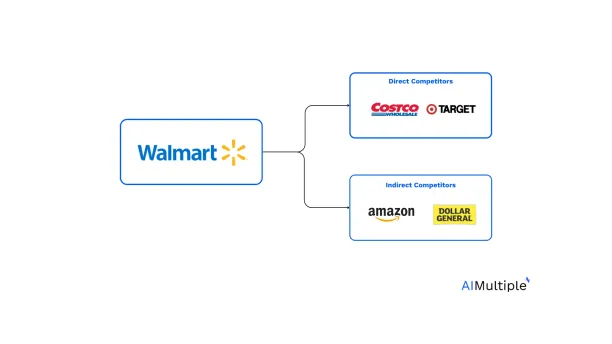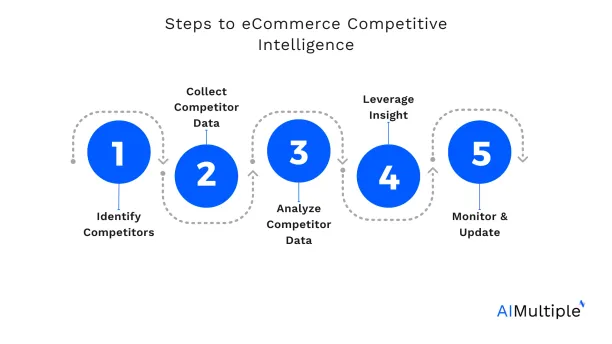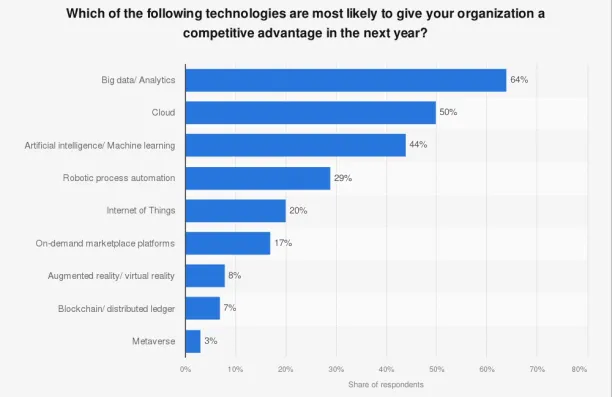eCommerce Competitive Intelligence in 2024: 5 Benefits & Tools
As more startups join the e-commerce industry, the level of competition rises (Figure 1). To succeed in today’s highly competitive market, online retailers need to achieve competitive intelligence. By understanding the competitive landscape, e-commerce businesses can make informed decisions and strategically position themselves to stay ahead of the curve.
This article will delve into what competitive intelligence means for the e-commerce sector, how online businesses can achieve it, and the top 5 benefits it offers. Moreover, we’ll explore the top 5 considerations when selecting the right competitive intelligence tool for your e-commerce business.
Figure 1. The European e-commerce sector grows
Comparison of the 5 best e-commerce competitive intelligence software providers on the market
This section compares the top 5 e-commerce competitive intelligence software providers on the market.
Table 1. Vendor comparison based on market presence criteria
| Companies | Number of Employees | Customer Reviews* | User ratings (out of 5)* , *** |
|---|---|---|---|
| Bright Data / Bright Insights | 450+ | 139 | 4.7 |
| Wiser Solutions | 511+ | 52 | 4.3 |
| DataWeave | 277+ | 78 | 4.4 |
| Stackline Atlas | 250+ | 72 | 4.4 |
| Bungee Tech | 85+ | N/A | N/A |
Table 2. Vendor comparison based on commercials criteria
| Companies | Price range/month** | Free Trial** | Demo** |
|---|---|---|---|
| Bright Data / Bright Insights | Range: $1.5k to $2.5k/M | TRUE | TRUE |
| Wiser Solutions | N/A | FALSE | FALSE |
| DataWeave | N/A | FALSE | TRUE |
| Stackline Atlas | Range: Free to $1499/M | FALSE | TRUE |
| Bungee Tech | N/A | FALSE | TRUE |
Table 3. Vendor comparison based on feature set criteria
| Companies | Deployment** | ISO/IEC 27001 Certification** | GDPR Compliance** |
|---|---|---|---|
| Bright Data / Bright Insights | Web application Cloud Mobile app Desktop | TRUE | TRUE |
| Wiser Solutions | Web application | FALSE | TRUE |
| DataWeave | Web application | FALSE | FALSE |
| Stackline Atlas | Web application | FALSE | FALSE |
| Bungee Tech | Web application Mobile app | FALSE | FALSE |
Notes from the tables:
- * Based on data from G2
- ** Based on data available on vendor’s website
- *** While some companies on this list have multiple products, all their products are merged into a single product in review sites. In the case of such companies, the scores come from that single product. Therefore the number of reviews of their market intelligence product is significantly overestimated.
- All companies compared were narrowed down based on having 50+ employees and the relevancy of their services.
- All vendors offered real-time analytics and Price monitoring features.
How we chose the top e-commerce competitive intelligence software vendors for comparison
There are various sophisticated tools on the market that are specially designed to help e-commerce businesses implement competitive intelligence. These considerations can help you narrow down your options. We divided the criteria into 3 categories:
- Market presence
- Commercials
- Features
Market presence
The initial set of criteria to consider when selecting an ecommerce competitive intelligence platform pertains to the vendor’s presence in the market. The key factors in this category include; company size (number of employees), feedback from customers, and user ratings.
1. Company size (number of employees)
The size of any software vendor can be indicative of its stability, scalability, and support capabilities. Larger organizations often have strong customer support structures, while smaller businesses may provide more personalized service.
However, this is not always the case; some large organizations prioritize their biggest customers over the smaller ones, therefore, it is important to communicate this with the vendor.
2. Customer reviews
You can also consider looking at customer reviews from trusted platforms such as G2. Customer reviews offer a real-world view into how the platform performs and the quality of the service provided. The more customer reviews a vendor has, the better you can understand about its solution and services. Avoid working with companies with consistently poor reviews or unaddressed customer complaints.
3. User ratings
User ratings, often displayed on a scale of one to five, offer a quick overview of the vendor’s performance and make it easy to compare the platform’s performance against its competitors. A higher level of rating typically shows higher user satisfaction, while lower ratings can indicate potential issues with the company’s solution or services. We gathered user rating data from trusted platforms such as G2.
Commercials
The commercials category includes the most crucial factors to consider while shopping for any software solution. Factors like pricing, free trials, and demos.
4. Pricing
In this economically challenged business environment, it is important to consider how a vendor’s pricing fits within your budget. Remember, the priciest solution is not always the best, and the cheapest may not offer the necessary features you require. The aim here is to search for a balance of cost and functionality that aligns with your business needs.
5. Free trials
Free trials allow you to get a hands-on experience of the software features and user interface before making any financial commitment. This is an excellent opportunity to explore the solution, clarify any confusion, and assess its performance.
6. Demos
Demos are similar to free trials since they also provide a hands-on experience with the solution. However, they are usually guided by a company representative. Demos are important for educating the workforce regarding the solution. Some companies offer both free trials and demos, which also indicates that the vendor is transparent about its solution’s performance.
Feature set
The third category relates to the features offered by the vendor. This set of criteria can be more personal for businesses since everyone has unique needs regarding features. However, there are common features that can be considered while comparing vendors.
7. Deployment
The question to consider here is if the platform offers flexible deployment options? Depending on your resources and business model, you might prefer a cloud-based, on-premises, or hybrid deployment. You might also want to leverage the platform through a mobile app.
8. Real-time analytics
A good competitive intelligence platform should offer real-time analytics capabilities. This is a must-have feature for most software in the current market. Real-time analytics capabilities allow you to monitor activity and trends as they happen, enabling quicker responses in the volatile ecommerce market.
9. Price monitoring features
Price monitoring is one of the most important element of competitive analysis and dynamic pricing strategies. A service that offers effective price monitoring features can give you an edge in a highly competitive ecommerce market.
10. Data protection
As cybersecurity threats rise, businesses become more protective of their data. It is important for the vendor to have the necessary data protection measures in place. For this comparison, we considered the ISO/IEC 27001 certification and GDPR compliance.
What does competitive intelligence mean for the ecommerce sector?
In the ecommerce world, competitive intelligence refers to the process of systematically gathering, analyzing and leveraging data and information about your competitors. This intelligence helps businesses to make data-driven decisions, identify trends and opportunities, and ultimately gain a competitive advantage in the market.
Achieving competitive intelligence for online businesses
This section covers some steps to achieve competitive intelligence for ecommerce businesses.
1. Identify competitors
Initially, you need to identify your main competitors, both direct and indirect. Direct competitors are those who sell similar products or services, while indirect competitors target the same audience but offer different products or services. For instance:

2. Collect data
Collect information about your competitors, such as their product offerings, pricing, marketing strategies, customer reviews, and social media presence. You can do this manually or with automated tools such as web scraping.
3. Analyze data
Analyze the collected data to identify trends, strengths, weaknesses, opportunities, and threats. If the data from your competitors is large, you can use a sophisticated ecommerce analytics tool with built-in competitive intelligence capabilities.
4. Leverage insights
Use the insights gained from your analysis to make strategic decisions, such as refining your product offerings, adjusting pricing strategies, or improving your marketing efforts.
5. Monitor and update
Continuously monitor and update your competitive intelligence practices to ensure that you stay ahead of the game.
Figure 2. Process of achieving competitive intelligence

Why is achieving competitive intelligence necessary for online businesses?
Studies show that Big data and analytics are most effective in helping companies achieve competitive advantage (Figure. 2). Competitive intelligence is a set of practices that can help your online business harness the power of big data and analytics.
Figure 2. Technologies that are most likely to help businesses achieve competitive advantage in the future

Here are some benefits of competitive intelligence in the ecommerce sector:
1. Enhanced product offering
Analyzing competitors’ data allows ecommerce businesses to identify gaps in their product offerings and make informed decisions on which products to introduce or discontinue.
For instance, an online clothing retailer may discover that their competitors offer a wider range of eco-friendly products, prompting it to expand its sustainable clothing line.
2. Optimized pricing strategy
By analyzing competitor pricing data, online businesses can establish an optimal pricing strategy that balances profitability and competitiveness. A consumer electronics retailer might discover that its competitors offer free shipping on orders over a certain threshold. With this data, it can implement a similar or better policy to remain competitive.
3. Improved marketing efforts
Competitive intelligence helps ecommerce businesses identify successful marketing tactics used by competitors and adapt them to their own campaigns. An online cosmetics store, for example, might notice that a rival is generating significant engagement through online influencer partnerships (such as with popular YouTubers) and decide to pursue a similar strategy.
4. Superior customer experience
Understanding the customer experience offered by competitors allows ecommerce businesses to identify areas for improvement in their own user experience.
Suppose an online furniture store discovers that one of its competitors offers 3D visualization features to improve its customer experience. This can inspire the brand to incorporate similar technology on its website or mobile app.
5. Focused innovation
Competitive intelligence can reveal market trends and emerging technologies, empowering online businesses to innovate and stay ahead of the competition. You can keep an eye on what new technologies are being used by your competitors and improve or enhance your technological capabilities accordingly.
One of the main reasons this approach is effective is because whatever solutions your direct competitors use will fit perfectly (or with minor tweaks) in your business operations since they are similar.
Recommendations
The data and insights gathered from competitive intelligence approaches should not only be used to copy competitors’ practices and initiatives. In some cases copying works, but the data can also be used to offer something even better. So it is important to consider improvements or adding your own personal touch to whatever practices you decide to incorporate into your business.
Transparency statement
Numerous emerging tech companies, including Bright Data, are sponsors of AIMultiple.
In this guide, AIMultiple analyzed various market intelligence software using relevant, public, and verifiable data and criteria.
Further reading
- Guide to Competitive Intelligence in eCommerce
- Top 10 eCommerce Analytics Tools & Selection Guide
- Unlocking Business Success with Market Intelligence
If you need help finding a vendor or have any questions, feel free to contact us:

Comments
Your email address will not be published. All fields are required.